Now that the deck and the keep have both been refinished, the outhouse has been looking even worse than usual by comparison. The door sticks and sometimes won’t even close. The seat’s at an uncomfortable height and depth. It’s covered in cobwebs and open to all manner of critters. And the aging wood has been absorbing unspeakable horrors for the better part of four decades. It needs to go. While not the most glamorous project, it’s hard to argue against the importance and necessity of an outhouse, so some real thought needs to go into its replacement.
Like many projects up here, this one started in SketchUp. I designed a simple four-foot square plywood platform that stands on joists made from the leftover treated 2×8 lumber from the deck. The framing would be done with 2×4 studs, I’d install two windows that I had found in the pole barn, and the whole thing would be panelled with the pine plywood siding that was stacked under the big house trailer. I still needed a roof and a door. My hope was that I could reuse the roof from the old outhouse, so I just had to track down a suitable door. I turned to craigslist and was in luck; I found an outswing, exterior, prehung door for only $40. It was 36″ wide, which is a bit much for this little building, but it was hard to argue with the price.
I hauled all the materials back to my garage in Oshkosh where I’d have more time to work on assembly in the evenings after work. I wanted to be sure that any, uhm, deposits made in this new facility would go straight down and not get absorbed into the building materials, so I fashioned a liner out of a plastic 55-gallon drum. I had to cut it down to get the slimmer depth required by the bench, so the overall cross-section is more like a football now. The two drum halves are joined by nuts, bolts, and washers and sealed with silicone. With the most important piece out of the way, I turned my attention to the base, which went together quickly.
Next up was the framing. This building is a little small to design around studs 16″ on center with standard joined corners, so I engineered my own weird solution. The whole thing is built around four pillars—triple 2x4s in the front and double 2x4s in the back. The outermost studs are notched to allow horizontal 2×4 studs to form the side walls. The rear pillars are capped on the top and bottom by studs and the rear wall is framed traditionally. A double-stud completes the top of the front wall/door opening. This was all assembled off of the base so that I could still clear my garage door. I finished the frame assembly by installing the windows, which had cleaned up quite nicely and looked brand new.
I picked through the rescued pine panels and found the biggest, cleanest sections to use for the walls. I cut these to size, nailed them to the frame, and moved the whole thing out into my driveway. I sprayed the assembly liberally with deck cleaning soap, then gave the panels a thorough blast from my pressure washer. While this was drying, I laid self-adhesive floor tiles on the platform. I rocked the frame assembly back, propped it up with a scrap 2×4, and screwed two short 2×4 stilts into the sides. I repeated this for the back, then slid the platform underneath the frame. I removed the stilts, did some final repositioning, and secured the frame to the base. No turning back now.
I used some metal stair edging to finish the front of the platform and keep the tile from peeling back. I taped this off and started painting the panels. I found a “light charcoal” gallon of Maxbond satin finish paint in the mistint section at Menards, so the total cost of painting was only$5. The old plywood was very thirsty and the whole thing took about 3/4 of a gallon. Worth the effort, though; the panels look brand new. I laid a sheet of plywood across the top of the liner and brought out a toilet seat from the house to “test fit” and align things for the eventual hole. I had based the final seat height around the measurements of a standard tall-bowl toilet, so this should be a lot more comfortable than the old seat.
Once the paint was dry, I screwed two eight-foot 2×4 studs into the back wall, tipped the whole assembly over onto a furniture mover cart, and lifted the other end to pull it back into the garage. I wanted something a little more sophisticated than a hanging extension cord to provide power to this thing, so I installed an outlet in the back wall and a junction box high on one of the outside walls. There was already a circle cut out of this panel, so I put the junction box right over it. The idea is to have a light with a day-night sensor that will also run an attached section of Christmas lights. The whole setup ends with a four feet long power cord that comes out of a plastic grommet five feet up the back wall. This has a nice clean finish and keeps the power connection out of the dirt.
I cut and installed interior wall paneling from luann plywood that, like the exterior panels, had been pulled from under the big house trailer, soaked with soap, and pressure-washed. Once this was all in place, I built the frame for the bench seat. The frame is incomplete on purpose; I want a minimal cross-section in the front so that the liner is as far forward as possible. The bench won’t sag though, the top section of 3/4″ plywood is designed to rest on a second piece of plywood across the front. I brought the toilet seat back out to trace a template for a hole in the top piece of plywood, cut that out, and screwed everything together. I also cut and installed some exterior window trim and interior panel trim.
The final order of business was the door. I wheeled this (now heavier) shack back out to the driveway, carefully stood it up, and set the door frame in place. After some shimming to get everything plumb, I screwed it in place and Outhouse 2.0 was as done as it could be at this stage. I borrowed Dad’s ATV trailer to haul it up to Puckaway for the rest.
The dream of reusing the roof from the old building died quickly. It crumbled apart while I was detaching it. Oh well. I hauled away the old outhouse (and roof) and brought the new one in. I got it into position and it seemed really unstable. The metal barrel that lines the hole actually pushes up higher than the bricks that supported the old building frame. It needs another layer. Red helped me add the bricks while I tipped the outhouse out of the way. Now on steady footing, I made the final cuts in the top of the liner, drilled holes to mount the seat to the top sheet of plywood, and sanded around the opening for reasons that should be obvious. The final step of preparation was to apply some clear silicone around the front of the hole where the barrel liner meets the plywood, as well as the entire rim of the hole in the plywood. I don’t want any chance for this wood to absorb anything.
We still needed a roof. I was going to pull plywood from the back of the pole barn to add shingles to later, but ended up finding something even better. We took a 4′ square ROAD CONSTRUCTION AHEAD sign and sealed it to the building with screws and silicone. It has a very small profile and looks pretty cool. The final step was to add some lights. I don’t have an outdoor fixture yet, so I strung a section of Christmas lights around the perimeter. The remaining lights were plugged into the back wall outlet to brighten up the interior. Doesn’t look half bad this way, but they’ll get cleaned up further when I add a light with a day-night sensor.
As long as the tube of silicone was out, I hit every inside corner with it. I’m hoping to make this as bug- and critter-proof as possible, with the only opening being the actual hole. And I don’t think many things will find their way up from there. Outhouse 2.0 got put to use the same day it was finished and passed with flying colors. It also passes the eye test—it looks much better in the yard than its predecessor. This should last us until the day we finally get proper septic up here.
- I didn’t want anything to be absorbed on its way down, so the liner is made from a plastic 55-gallon drum. I cut it down for a slimmer profile.
- The majority of the building materials were repurposed from old projects (like the deck) or general Puckaway stock.
- Traditional framing would add a lot of unnecessary weight and bulk, so I went with a four-pillar design where the side walls are notch-fitted.
- The wall panels had been stored under the big house trailer for a few decades and needed a high-pressure scrub down.
- These self-adhesive tiles were only $0.69/ea at Menards and were dead-easy to apply and trim.
- The initial test fit of the seat. I wanted to have things as far forward as possible.
- The framing for the bench is kept to a minimum near the opening to allow for the tightest possible fit.
- A fresh coat of paint brings the panels back to life. I lucked out and found some Maxbond on the $5 mistint shelf at Menards.
- Window trim and $40 craigslist door installed. The door was pre-cut for a deadbolt, but I found a filler plate on Amazon for cheap.
- The end of an era. Outhouse 1.0 is carted away to await its eventual viking funeral.
- Ready for placement. Two 2×4 studs are screwed into the back wall to prevent damage during loading and transport.
- Home at last. Just needs another layer of bricks to stabilize the foundation.
- The original plan was to reuse the old roof. But that plan fell apart when the roof did. I like this solution better anyway.
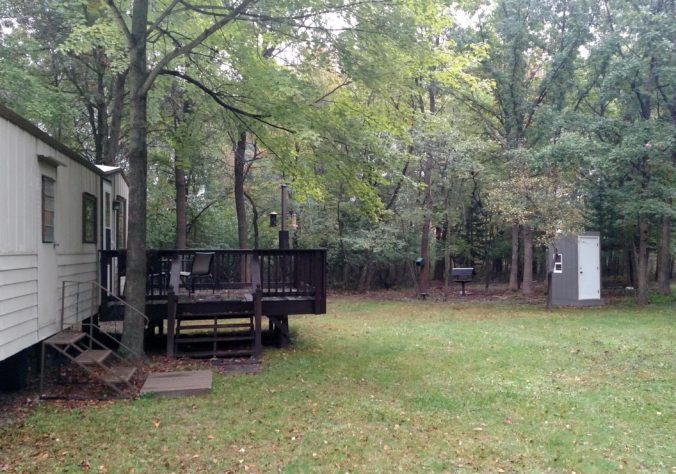

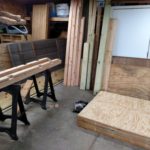
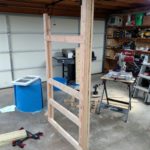





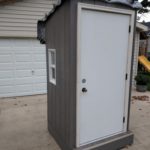
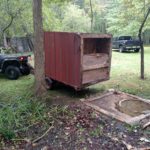




0 Comments
1 Pingback